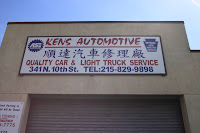The story behind Chinatown North cannot be understood without first being familiar with Philadelphia's Chinatown. Roughly defined as the area bounded by Vine, Filbert, 9th and 13th Streets, Chinatown is a bustling area on any given day, with its plethora of businesses ranging from restaurants to hair salons, supermarkets to hardware stores.
Prior to the construction of the Vine Street Expressway, Chinatown and Chinatown North were a contiguous entity. The Expressway, completed in 1991, has undoubtedly stressed the linkages between these two areas by presenting an indomitable physical barrier in the guise of a six-lane highway. Today, as demand for space burgeons out from the main Chinatown, Chinatown North is witnessing a rejuvenation of sorts. Housing projects that are significant to the community have been completed at a trickling pace, but projects in the pipeline promise to accelerate the growth of this area in the near future. At the same time, the adjacent Callowhill District is also rapidly metamorphosizing into what has been termed Philadelphia's "Loft District", and as Chinatown North emerges from its industrial past, the urban landscape is being slowly and meticulously crafted.
This project aims to recognize the multiplicity of forces that are shaping the evolving identity of Chinatown North, in the context of Philadelphia as an Immigrant City and greater Chinatown as an Immigrant Area. Through the photographic medium, the reader will be brought on a walking tour that criss-crosses the Chinatown North area, with the intersection of 10th and Callowhill Streets, where Ridge Avenue creates a six-directional junction, serving as the locus of the exploration.
Criss-Cross is a metaphor for both the wanderings of the urban flaneur, as well as the intertwined layers of community that can be found in Chinatown North. It is hoped that through this visual exploration, the reader is better able to grasp and appreciate the numerous disparate forces that create tensions of identity and growth in Chinatown North, around the imaginary center of gravity at 10th and Callowhill.
Prior to the construction of the Vine Street Expressway, Chinatown and Chinatown North were a contiguous entity. The Expressway, completed in 1991, has undoubtedly stressed the linkages between these two areas by presenting an indomitable physical barrier in the guise of a six-lane highway. Today, as demand for space burgeons out from the main Chinatown, Chinatown North is witnessing a rejuvenation of sorts. Housing projects that are significant to the community have been completed at a trickling pace, but projects in the pipeline promise to accelerate the growth of this area in the near future. At the same time, the adjacent Callowhill District is also rapidly metamorphosizing into what has been termed Philadelphia's "Loft District", and as Chinatown North emerges from its industrial past, the urban landscape is being slowly and meticulously crafted.
This project aims to recognize the multiplicity of forces that are shaping the evolving identity of Chinatown North, in the context of Philadelphia as an Immigrant City and greater Chinatown as an Immigrant Area. Through the photographic medium, the reader will be brought on a walking tour that criss-crosses the Chinatown North area, with the intersection of 10th and Callowhill Streets, where Ridge Avenue creates a six-directional junction, serving as the locus of the exploration.
Criss-Cross is a metaphor for both the wanderings of the urban flaneur, as well as the intertwined layers of community that can be found in Chinatown North. It is hoped that through this visual exploration, the reader is better able to grasp and appreciate the numerous disparate forces that create tensions of identity and growth in Chinatown North, around the imaginary center of gravity at 10th and Callowhill.





















